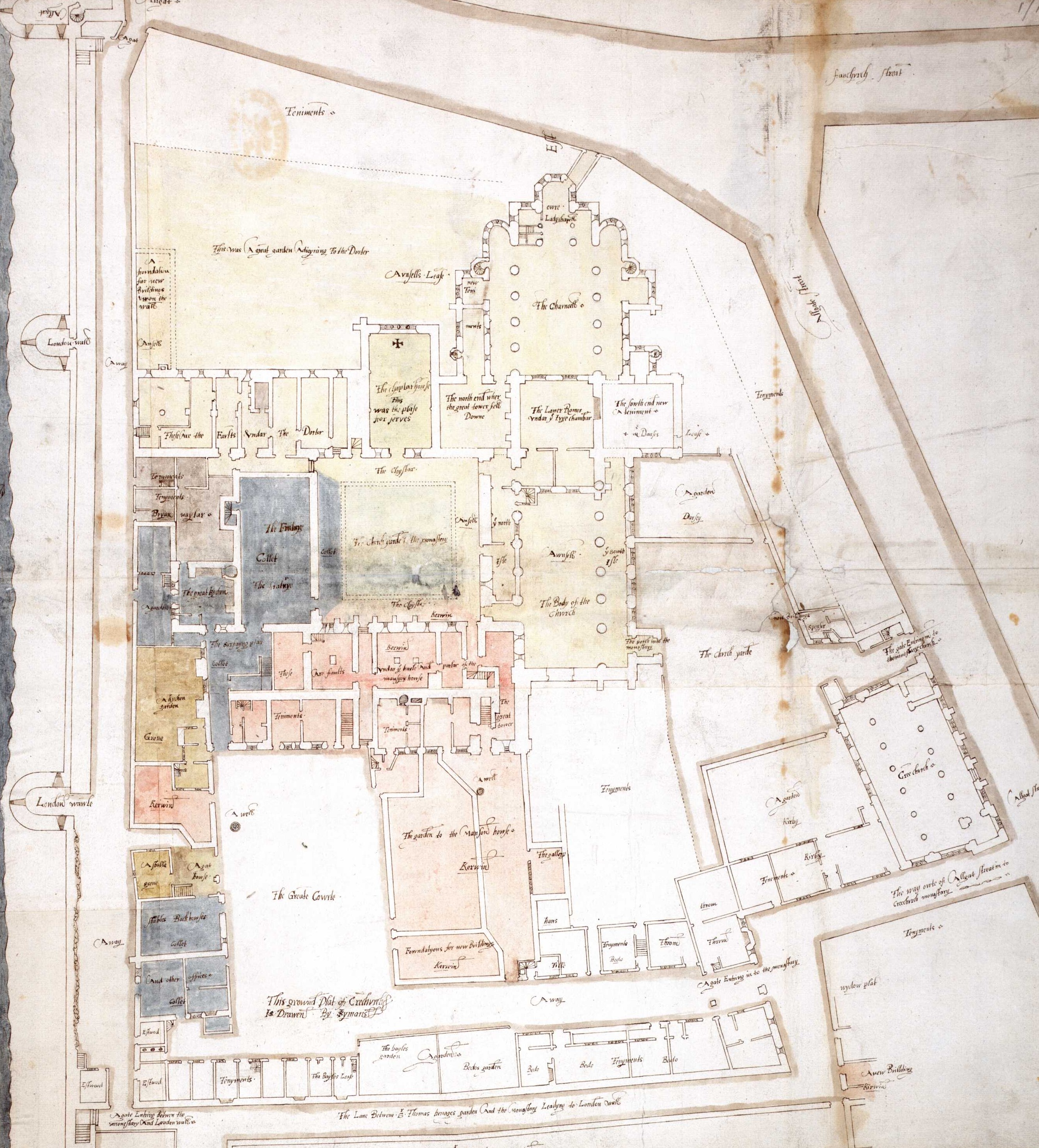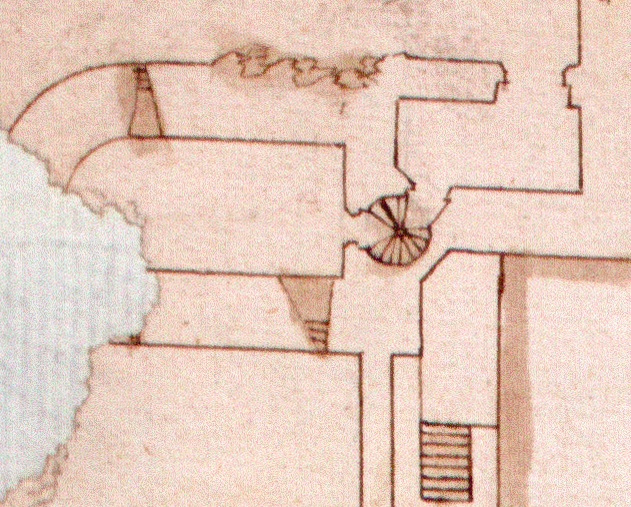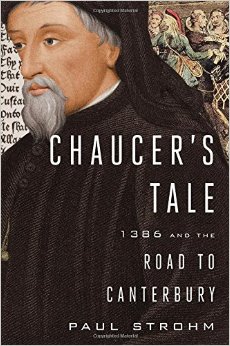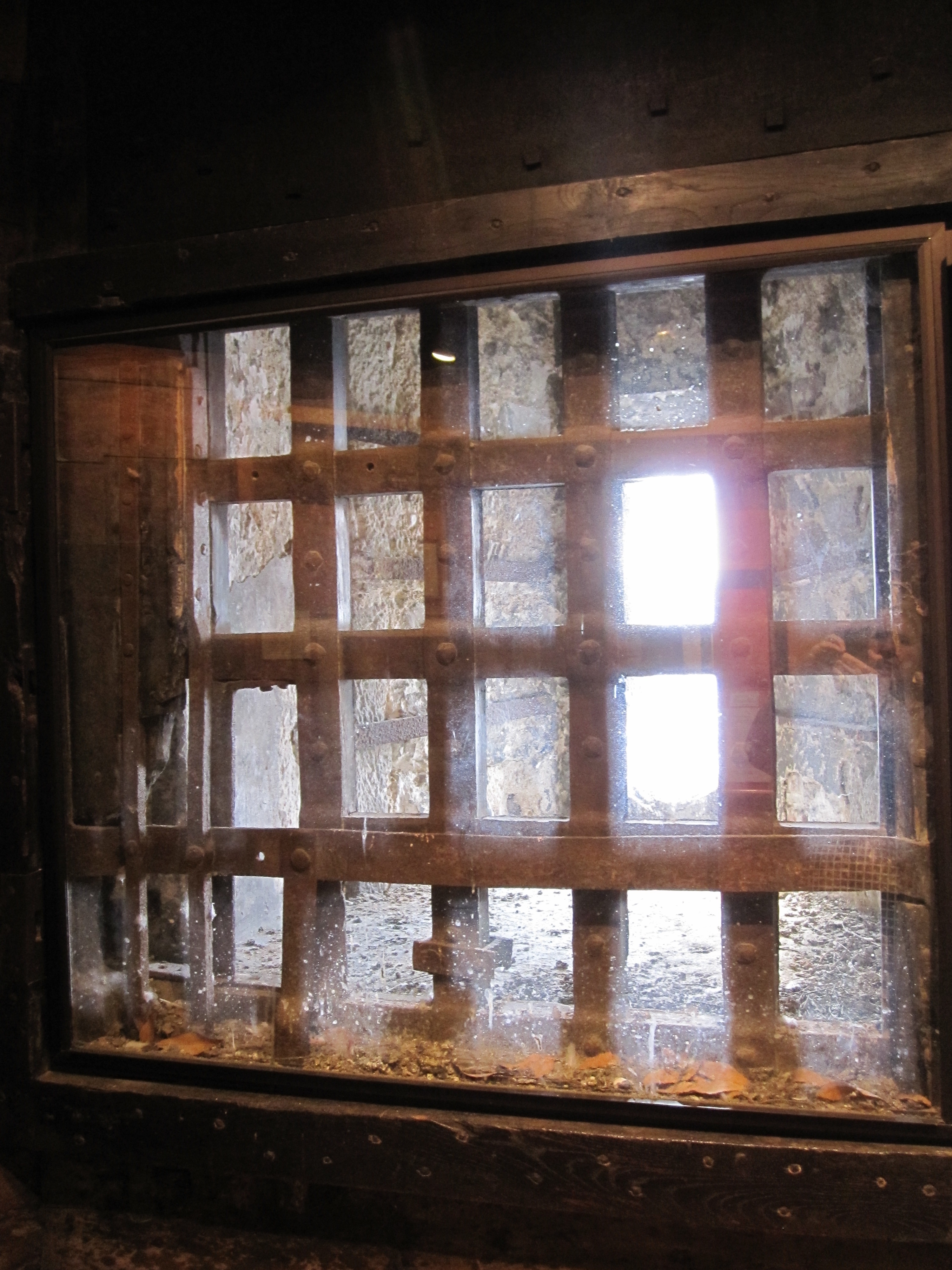By Paul Strohm (Guest Contributor)

Plan of Holy Trinity Priory, with Aldgate North Tower
When Chaucer obligingly stepped into a controversial job as Controller of the Wool Custom in 1374, one of his rewards was a rent-free accommodation over Aldgate, the easternmost and busiest of the City’s gates.
There, literally under his feet, passed royal and religious processions, spectacles of public humiliation, expelled convicts and sanctuary seekers, provisioners and trash-haulers with iron-wheeled carts and vans, drovers, water and wood sellers, traders, runaway serfs, 1381 rebels flowing in from Essex, and all the rest of a busy city’s shifting populace . . . Surely no residence more fitting could be imagined for a poet whose subject was soon to become, as Dryden would put it, “God’s plenty.”
But what kind of a place was this, really? Chaucer’s lease for his dwelling survives, describing it with the Latin word for “mansion,” but this could be misleading; Latin mansio could be a sleeping room, a fine accommodation, or anything in between. Fortunately, while researching my Chaucer biography, I have found valuable new evidence.
Life over Aldergate

Tower, Upper Floor
In 1585 John Symonds (a joiner by trade but an exacting draftsman) prepared a detailed sketchmap of neighboring Holy Trinity Priory to facilitate its liquidation in the aftermath of its dissolution. Long unnoticed in the upper left hand corner of his sketch is a scale drawing of the Aldgate north tower, a close equivalent of the south tower in which Chaucer probably lived.
The archaeological “footprint” of this tower has it as some 26 feet in diameter, but (according to other examples and also the Symonds rendition) Chaucer’s room would have had walls at least five feet in thickness, reducing the size of the room to roughly 14 x 16 feet. The interior walls were of unfinished stone. The room’s sole illumination was provided by two (or at most four) arrow slits, wide on the inside for an archer’s access but then tapering to an aperture of four or five inches in the exterior stone wall. Light, even at mid-day, would have been extremely feeble. Arrangement for a small, open fire might have been possible. Waste would be hand-carried down to the open sewer of Houndsditch at the base of the tower. Meals would not ordinarily have been cooked there; London practice of the day was to eat on the run, at open kitchens or in taverns, with bread and other cooked food purchased directly from streetside ovens. Chaucer could have had access to the tower’s crenellated roof, but the stench of Houndsditch (serving the newly-built latrines of the populous and adjacent Holy Trinity) would have nullified the romance of rooftop exposure.
Nor can Aldgate with its dimly-lit and rough-finished stone interior be imagined as any sort of “family” accommodation. Chaucer’s elegant wife Philippa is, significantly, unnamed in his lease–even though such leases often contained the names of both husband and wife. This was, to be frank about it, no place for a classy lady like Philippa. During most or all of Chaucer’s 1374-86 residence in Aldgate, she and the children were living well in Lincolnshire with her notorious and prosperous sister Katherine Swynford, mistress and eventual wife of the awesomely empowered Duke of Lancaster, John of Gaunt. Any company in the tower would have been bivouacked troops, gatekeepers, and members of the City Watch.
Tower of Solitude
Chaucer’s solitude can easily be imagined and, at one moment in his poetry, he imagines it for us. The Aldgate tower is the imagined location to which the “Geffrey” of Chaucer’s House of Fame returns at night, when his “reckonings” at the Custom House are through. His guide in that poem, the overbearing Eagle, taunts him about his solitude:
. . . of thy very neighebores,
That dwellen almost at thy doores,
Thou hearist neither that ne this . . .
Thou goest home to thy house anoon,
And, as dumb as any stoon,
Thou sittest at another book
Til fully dased is thy look;
And livest thus as an heremite . . .
The Eagle undoubtedly has it right. Whatever transient guests he may or may not have entertained along the way, Chaucer lived in Aldgate alone.
 Paul Strohm is Garbedian Professor of the Humanities, Emeritus, at Columbia University. His Chaucer’s Tale: 1386 and the Road to Canterbury was published November 2014 by Viking Press.
Paul Strohm is Garbedian Professor of the Humanities, Emeritus, at Columbia University. His Chaucer’s Tale: 1386 and the Road to Canterbury was published November 2014 by Viking Press.
References:
Illustration: the Symonds Sketchmap. Hatfield House, Library of the Marquis of Salisbury, CPM I/19, upper left-hand corner]
Chaucer’s lease: Martin M. Crow and Clair C. Olson, Chaucer Life-Records (Oxford University Press, 1966), pp. 144-47.
The quotation from Chaucer’s House of Fame, with spelling slightly modernized, is based on The Riverside Chaucer, ed. Larry Benson (Boston, 1987).
Images:
From Chaucer’s Tale: 1386 and the Road to Canterbury by Paul Strohm. Reprinted by arrangement with Viking, a member of Penguin Group (USA) LLC, a Penguin Random House company. Copyright Paul Strohm, 2014.

